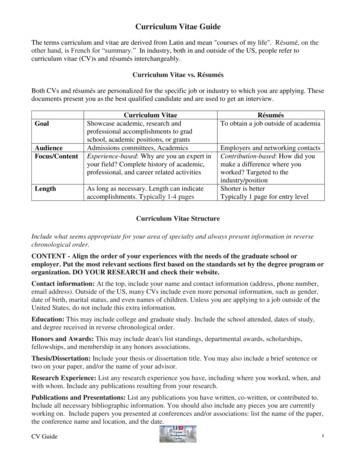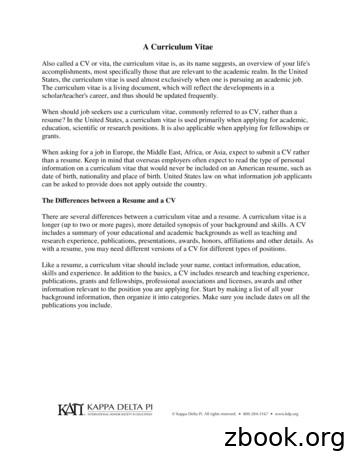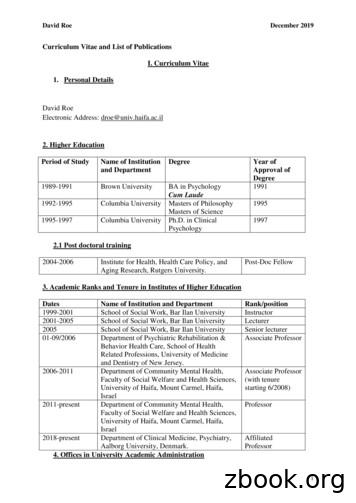WRITING A CURRICULUM VITAE (CV) - University Of North .
WRITING A CURRICULUM VITAE (CV)What is a Curriculum Vitae/CV?A curriculum vitae or CV is similar to a resume. Both are summaries of your educational background, professional experience, andrelevant skills. A CV typically is for application to research or teaching positions in an academic or research setting and for somegraduate programs. A resume is for most positions outside these fields, and for some professional programs (e.g., Social Work,MBA). The term “resume” is not often used outside of the United States – most other countries prefer to use “CV.” See theresource, Going Global global), for information on writing a CV for a positionoutside of the United States.Purpose and ContentA CV may run several pages. It often covers educational background, research experience, teaching experience, professionalexperience, service experience, honors and awards, and professional or academic memberships. A CV may also include selectedcoursework. For an undergraduate who is building their career, a first CV may run 1-3 pages. Graduate/Professional student CVs mayrun 2-4 pages. A person with more experience or relevant content may require 4-7 pages. An established professional may boast aCV of 10 pages or more.CVs display name and contact information at the top, often in a header. Contact information should include a professional emailaddress (your college/university email will work), and may include local mailing address, telephone number, or links to professionalwebsites (e.g., LinkedIn). Omit references to age/date of birth, marital status, children, health, religious affiliation, politicalaffiliation, etc.Most CVs address at least education, research, teaching, and service experience, although headings for these and other sectionsvary. When describing experiences, use action verbs and incorporate evidence and outcomes. A list of possibleheadings/subheadings appears on the next page. The order of sections depends on your career or academic goals, as well as thefocus of the programs or positions you apply to. For applications for graduate/professional schools - research and teaching may be highlighted over work experience whenapplying to programs that require you to conduct research and/or provide teaching. For applications to academic/faculty positions - When applying to a college or university that is teaching-focused, andwhere teaching and student performance are highly valued, it may be wise to show teaching experience before research orservice. Likewise, when applying to an institution that favors research output, it makes sense to lead with researchexperience over teaching and service.Education: Your first category should be education. List all colleges or universities attended, city and state for each, degrees earned,area(s) of study, G.P.A., and graduation dates. Lead with your most recent degree. If you have an honor’s thesis, Master’s thesis ordissertation, include the title (or topic). You may also wish to include names of your primary advisor(s).Research: Include any positions you have held as a research assistant, or as a lab assistant, as well as any presentations orpublications related to your research. You may use subheadings to organize this section. Not every student will have substantialresearch experience, but you could describe your research interests or list relevant research papers or projects that you completedfor a class (such as an honors paper or a capstone project).Teaching: Include any positions you have held as a teacher or teaching aide/assistant, along with information about the coursestaught/assisted. Not every student will have teaching experience, but you could include other experiences working with students.Tutoring, mentoring, and peer counseling could fit within this category. Some graduate/professional students distinguish betweencourses taught (e.g., as “instructor of record”) and courses assisted (e.g., as “teaching assistant”). Additional categories can includeteaching interests, notable accomplishments, etc.Service: Service is a broad category on a CV. It may include paid and unpaid work done on behalf of an organization, community, orcollege/university. Examples include volunteer work, involvement in campus organizations, student leadership, committeeparticipation, or membership in professional associations. Again, subheadings can help you organize different types of service work.UNIVERSITY CAREER SERVICESThe Wendy P. and Dean E. Painter Jr. Career Center(919) 962-6507 careers.unc.edu ucs@unc.eduCOPYRIGHT 2018 UNC Chapel Hill University Career Services
WRITING A CURRICULUM VITAE (CV)Additional Categories: A CV may also include honors, awards, scholarships, or special recognition you have received. You may alsoinclude selected or relevant work experience. If you are using the CV for application to a graduate/professional program, you maywant to list coursework that demonstrates readiness for advanced study. Public performances, exhibitions, or additionalpublications may also be relevant.Category headings and subheadings vary. Pick labels that accurately reflect teaching, research, and service experience, and thatemphasize strengths and achievements. Additional examples of headings and subheadings appear below. Some of these are moreappropriate for graduate/professional students.Honor’s ThesisMaster’sThesis/DissertationSkillsFieldwork or PracticumResearch/Teaching AssistantshipsResearch/Academic InterestsResearch/Teaching ExperienceRelated ExperienceAdvising/MentoringUniversity Involvement/ServiceLeadershipStudent GovernmentProfessional DevelopmentCommittee/Departmental LeadershipAdvisory Boards/CommitteesResearch PresentationsConference PresentationsAbstractsPublications/Selected PublicationsScholarly/Technical PapersArticles/MonographsMultimedia MaterialsResearch Awards/Grants/ContractsScholarshipsFunded ProjectsHonors and AwardsExhibits/ExhibitionsPerformancesAcademic AwardsFellowshipsGuest Lectures/PresentationsExtracurricular ActivitiesAffiliations/MembershipsHonorary SocietiesCertification/LicensureStudy AbroadInternational ProjectsLanguagesTeaching InterestsCommunity OutreachPatentsReferences: Prepare a separate sheet for references, and format it so that the heading is consistent with the CV. Supply the title, name,address, telephone/fax number, and email address of 3-6 individuals who can comment on the applicant’s ability to succeed in thespecific position.References know the applicant and their work well. Keep references updated on professional activities and provide them with a currentcopy of the CV. Consider references with high external visibility. Get a reference’s permission before submitting their names to aprospective employer, and advise a reference that they may be contacted.Sample CVs Graduate/Professional Students - Three sample CVs from different fields are provided with this handout. For each CV, a shortcommentary about their design choices is provided, along with suggestions for altering the CV to suit differentacademic/research positions. Undergraduate Students - Two samples are provided; one for STEM and one for humanities/social sciences.Although these CVs are examples, CV design varies considerably even within a single discipline. Templates are also provided on ourwebpage for your convenience. You are encouraged to explore additional examples online and to meet with a UCS staff member forfeedback on your CV.Converting a CV to a ResumeIf you are starting with a CV, you may find that you also need a resume for particular career fields. Tips on converting your CV to aresume can be found at the end of this packet. See the packet of resume templates on the UCS site for additional ideas.UNIVERSITY CAREER SERVICESThe Wendy P. and Dean E. Painter Jr. Career Center(919) 962-6507 careers.unc.edu ucs@unc.eduCOPYRIGHT 2018 UNC Chapel Hill University Career Services
AMY LARKIN101 Main Street, Raleigh, NC 27606(919) 515-5555 test@email.unc.eduEDUCATIONPhD, Nutrition Intervention & PolicyExpected December, 2012Gillings School of Global Public Health, University of North Carolina at Chapel Hill Dissertation: Using Online Social Networking Technology to Increase Social Support for Exercise: The INSHAPEStudy. Committee: Alice Ammerman, DrPH, RD (Chair), Jane Brown, PhD, Robert DeVellis, PhD, Amy Ries, PhD,Deborah Tate, PhDMPH, NutritionAugust, 2008Gillings School of Global Public Health, University of North Carolina at Chapel Hill Master's Thesis: Addressing Youth Obesity Through a Web-Based Wellness Policy Toolkit for Obesity Preventionin Middle Schools at the UNC Center for Health Promotion and Disease PreventionCertified as aRegistered DietitianBA, cum laude, EconomicsBoston UniversityMay, 1995SUMMARY OF RESEARCH SKILLSProject management * grant and proposal writing * research methodology & design * Institutional Review Board clearance* participant recruitment * data collection * data management * statistical analysis (SPSS, Mplus, ATLAS.ti) * online surveydesign and programming (Qualtrics) * oral presentations * cost effectiveness analysisRESEARCH INTERESTSObesity * obesity related co-morbidities * physical activity * nutrition * social support * technology-based healthinterventions * structural equation modeling * health behavior theory * health communications * research dissemination &translationAWARDS AND HONORS Cancer Control Education Program, Predoctoral Fellowship, Lineberger Comprehensive Cancer Center, UNC(5R25-CA057726), 2010-2012, 41,000 per annum NIH National Service Research Award, Predoctoral Traineeship, Department of Nutrition Training Grant, UNC(2T32-DK07686), 2009-2010, 29,999 University of North Carolina Graduate School Merit Assistantship, 2008-2009, 29,000 American Dietetic Association Foundation Geraldine M. Piper Memorial Scholarship, 2010-2011, 1,000RESEARCH EXPERIENCEDissertation ResearchJanuary 2010 - PresentUNC Gillings School of Global Public Health, Chapel Hill, NC Independently conducted a randomized controlled health intervention trial with 134 participants and a 90 percentretention rate. Developed and administered Qualtrics online questionnaires at 3 time points using existing instruments andprocess measures developed specifically for the intervention. Conducted 24 qualitative structured interviews and manually documented over 800 intervention discussion boardposts. Collected, managed, and analyzed data on over 200 variables using structural equation modeling, analysis ofvariance, and descriptive analysis techniques.Graduate Research AssistantJune 2006 - PresentUNC Center for Health Promotion and Disease Prevention, Chapel Hill, NC Managing a content development team for a CDC funded weight loss intervention targeting low-income familyplanning clinic patients. This work has included the creation of 8 web based educational modules withassessment questionnaires, a 26-week online behavioral self-monitoring system with tailored feedback, and thedevelopment of an online social network based social support program. Contributed significantly to the background, research design, analysis, and budget sections of 5 NIH grantsubmissions including the successful submission of a 133,000 phase 1 NIH STTR grant. Three submissions arein development or pending review. Prepared and managed several complex IRB applications for grant-funded health interventions. Served on successful Deputy Director for Research and Operations search committee for the UNC PreventionResearch Center (Center for Health Promotion and Disease Prevention).
AMY LARKINp. 2TEACHING & MENTORING EXPERIENCETeaching AssistantSpring 2008 & Spring 2009NUTR/HPM 780, Entrepreneurship in Public Health Assisted in the development of all course content and assignments. Managed speakers, class group assignments, and student inquiries. Evaluated students by providing written feedback and grades for 9 one page written assignments and a 15 pagefinal paper. Taught one, two-hour class per semester.UNC Undergraduate Research MentorJune 2010 - July 2011 Recruited and hired 3 undergraduate interns for dissertation research through the UNC Office for UndergraduateResearch. Scheduled and oversaw regular meetings and managed intern activities including the transcription and coding ofover 11 hours of qualitative interviews. Provided recommendations and career advice as needed.PROFESSIONAL EXPERIENCEHealth Communications InternAug 2007 – May 2008North Carolina Division of Public Health, Raleigh, NC Physical Activity and Nutrition Branch Developed a radio and print health communications campaign for the statewide Eat Smart Move More program,"Maintain Don't Gain". Wrote press releases and articles on school wellness topics for dissemination to PTAs and the North CarolinaSchool Board Association.Dietetic InternUNC Hospitals, Chapel Hill, NC Collected data and evaluated patient nutritional risks and status. Recommended medical nutrition therapy and counseled patients. Documented patient information and interventions.June 2007 - Aug 2007Manager, New Business DevelopmentApril 1998 – Aug 2005National Public Media, New York, New York Consistently exceeded multi-million dollar fundraising goals. Developed 1.8 million dollar television, radio and PBS Ready To Learn program sponsorship for PNC Bank. Created and managed partnerships between commercial and non-profit sales organizations.PUBLICATIONS AND PRESENTATIONSPublications Smith A, Jones B, Larkin A, Charles AF, Johnson, TJ. Health economics in public health. American Journal ofPreventive Medicine. 20xx Mar;36(3):273-5. Peterson A, Larkin A, Jones A. Linking homegrown and locally produced fruits and vegetables to improvingaccess and intake in communities through policy and environmental change. Journal of the American DieteticAssociation. 20xx Apr;107(4):584-5 (Application) Smith A, Lee MM, Larkin A. Addressing disparities in the obesity epidemic. North Carolina Medical Journal. 20xxJul-Aug;67(4):301-4. Larkin A. Using return on investment analysis to evaluate health promotion programs: challenges andopportunities. RTI Issue Briefs. 20xx November: 1(3): 1-4.Oral Presentations Larkin A. Johnson, D, Jones, L, Bailey, A, Gaston, M, Lee, Z, Smith, A. "Results From a Nutritional and PhysicalActivity Tracking and Screening Pilot Program in Middle Schools". 32nd Annual Meeting & Scientific Sessions ofthe Society of Behavioral Medicine. Washington, DC, 2011. Cavallo D, Gaston A, Johnson A, Smith A. “Entrepreneurial Approaches To Improved Snack Bar Offerings InSchool Settings”. International Society for Behavioral Nutrition and Physical Activity Conference. Banff, AB, 2008.PROFESSIONAL AFFILIATIONSMember, Society of Behavioral MedicineMember, American Dietetic AssociationCOMMUNITY SERVICE AND OTHER ACTIVITIESVolunteer, Meals on WheelsCompetitive Cyclist (Category3)Sept 2005-August 20061994-2005
Elaine Jackson250 Dogwood Drive, #2Glastonbury, CT 06833(111) rsity of Connecticut, Storrs,CTMay 2012Ph.D. in English LiteratureDissertation: “Rewriting the American Myth: Post- 1960s American Historical Frontier Romances”The dissertation studies writers who challenge the positivist, progressive mythology of the Americanfrontier in the wake of Vietnam-era protests, the Civil Rights Movement, and the American IndianMovement. Such writers as E.L. Doctorow, John Barth, Thomas Pynchon, Ishmael reed, PercivalEverett, Gerald Vizenor, James Welch, and Cormac McCarthy use their historical romances toaccepted texts, including new textual accounts that usurp the authority of accepted texts, andintroduced new voices into the discussion of frontier mythology.Major Advisor: Prof. Dennis MuelethalerAssociate Advisors: Prof. Carol Isakson, Prof. Larry MontiBoston College, Chestnut Hill, MAMaster of Arts in EnglishAugust 2003Northeastern University, Boston, MABachelor of Arts, Magna cum LaudeMajor: English; Minor: LinguisticsThesis: “Discovering God: The Figure of Beatrice in Poetry of Dante Alighieri”Thesis Advisor: Prof. Kathleen CarrTEACHING EXPERIENCEUniversity of Connecticut, Storrs, CTTeaching AssistantJune 2001Fall 2006 –presentCourses Designed and TaughtHonors III – American Literary Modernism: Writing Section (Fall 2011)Introduction to American Studies (Fall 2010)American Literature to 1880: Writing Section (Fall 2004 – Spring 2009 – 2011)American Literature to 1880 (Summer 2009, 2010, Spring 2011, 2012)World Masterpieces in English and American Literature (Spring 2011)Contemporary Issues/Contemporary Texts (Spring 2007)Texts and Contexts: Moby-Dick (Fall 2006)Freshman Writing 2: Madness, Depression, and Outright War (Spring 2006)Freshman Writing 1: Education and Society (Fall 2006)Course AssistedThe Short Story – Assisted Prof. ChartersFall: The World Short Story / Spring: The American Short Story (2007 – 2009)
Jackson, P.2TEACHING EXPERIENCE (CONTINUED)Eastern Connecticut State University, Willimantic, CTAdjunct LecturerSpring 2007 – presentCourses Designed and TaughtIntroduction to Literature (Spring 2007, 2009, Fall 2010 – Spring 2012)College Writing Plus: Environmental Rhetoric (Spring 2008)Responding to 9/11 (Spring 2010)Environmental Rhetoric (Fall 2004, 2009)Northeastern University, Boston, MAAdjunct LecturerJan. 2004 – June 2005Courses Designed and TaughtCollege Writing 2 (Winter 2004 – Spring 2005)College Writing 1 – On-line Trial Course (Fall 2004)College Writing 1 : Environmental Rhetoric (Fall 2004 – Winter 2004)Basic Writing: Environmental Rhetoric (Fall 2004)Boston College, Chestnut Hill, MATeaching FellowSept. 2002 – May 2003Course Designed and TaughtFirst Year Writing Seminar (Fall 2002 – Spring 2003)PUBLICATIONSRefereed Articles“ „Hardly the voice of the same man‟: „Civil Disobedience and Thoreau‟s Response to John Brown.”The Midwest Quarterly 48.2 (Winter 2012): 247-265.“ „A world away from his people‟: The Heartsong of Charging Elk and the Indian Historical Novel.” SAIL:Studies in American Indian Lectures 18.2 (Summer 2011): 54-82.“ „Of this I can make no sense”: Wuvand Eadwacer and the destabilization of meaning.” MedievalForum. Volume 4. (Posted 12/01/2009)“In the Midst of an Infernal Crowd: Dante and the Original Text(s).” Translation Review 58 (2004): 31 44.Under Review“Speaking for the Mixedblood Other: „Carefully Distorted‟ History in Gerald Vizenor‟s The Heirs ofColumbus.” Under review at MELUS: Multi-Ethnic Literature of the United States, 38 pp. (Notificationof Revise and Resubmit: February, 2012)
Jackson, P. 3PUBLICATIONS (CONTINUED)Miscellaneous“Representing Cooper‟s Cultural Landscape: The N. C. Wyeth Illustrations.” James Fenimore Cooper:His Country and His Art – Papers from the 2009 Cooper Seminar. Forthcoming, 10 pp.“Fools Crow.” Encyclopedia of Native American Literature. Fact on File, Inc. Forthcoming, 2013.“The Heartsong of Charging Elk.” Encyclopedia of Native American Literature. Facts of File, Inc.Forthcoming, 2013.Review of Fitz, Brewster E. Silko: Writing Storyteller and Medicine Woman. Norman: U of Oklahoma P,2009, in MELUS: The Journal of the Society for the Study of Multi-Ethnic Literature of the UnitedStates. Vol. 3 1.1 (Spring 2011): 156-158.“August 4, 1998.” Long River Review. 2010 Storrs: U of Connecticut P, 2010: 63-69.Review of Pulitano, Elvira. Toward a Native American Critical Theory. Lincoln and London: U ofNebraska P, 2008, in MELUS: The Journal of the Society for the Study of Multi-Ethnic Literature of theUnited States. Vol. 29.2 (Summer 2009): 300-01.“Gary Snyder.” Dictionary of Literary Biography 275: American Nature Writers- Prose. Detroit: Gale.2008. 294-302.“ the howling of Irish wolves against the moon.” Long River Review. 2004 Storrs: U of Connecticut P,2008: 123-125.“a syndeton.” Long River Review. 2006. Storrs: U of Connecticut P, 2006: 41-48.“For Kathy‟s birthday.” Poetic Voices of America. Sparrowgrass Poetry Forum. Sistersville:Sparrowgrass Press, Summer 2005: 29.“Sitting
What is a Curriculum Vitae/CV? A curriculum vitae or CV is similar to a resume. Both are summaries of your educational background, professional experience, and relevant skills. A CV typically is for application to research or te
Curriculum Vitae Guide The terms curriculum and vitae are derived from Latin and mean "courses of my life". Résumé, on the other hand, is French for “summary.” In industry, both in and outside of the US, people refer to curriculum vitae (CV)s and résumés interchangeably. Curriculum Vitae vs. Résumés
CV curriculum vitae CV v. resume – Length – Scholarly/scientific. Curriculum Vitae CV curriculum vitae CV v. resume – Length – Scholarly/scientific – Detailed. Curriculum Vitae (CV) Name, title, curren
A Curriculum Vitae Also called a CV or vita, the curriculum vitae is, as its name suggests, an overview of your life's accomplishments, most specifically those that are relevant to the academic realm. In the United States, the curriculum vitae is used
3.0 TYPES OF CURRICULUM There are many types of curriculum design, but here we will discuss only the few. Types or patterns are being followed in educational institutions. 1. Subject Centred curriculum 2. Teacher centred curriculum 3. Learner centred curriculum 4. Activity/Experience curriculum 5. Integrated curriculum 6. Core curriculum 7.
TWAC Strategy 3: Assess Writing Across the Curriculum: 1) Content/Correct Answers, and 2) Writing TWAC Strategy 4: Teach New Writing Skills, Concepts, Strategies, and Techniques Across the Curriculum a. Create Assignments Across the Curriculum b. Use the Reading/Writing Connection and Literary Analysis Across the Curriculum
1 Curriculum Vitae and List of Publications I. Curriculum Vitae 1. Personal Details David Roe Electronic Address: droe@univ.haifa.ac.il 2. Higher Education Year of Approval of Degree Name of Institution Degree and Department Period of Study BA in Psychology 1991 Cum Laude 1989-1991 Brown University Masters of Philosophy 1995 Masters of Science
Vita vs. Vitae (pronounced VEE-tye, not VEE-tay) The correct term for the CV is the “curriculum vitae” Latin meaning “[the] course of [my] life” “vitae”is plural for the word “vita” but in the case of curriculum vitae, itis a modifier for the singu
Academic writing styles can vary from journal to journal, so you have to check each publication’s guide for writers and follow it carefully and/ or copy other papers in it. Academic writing titles cultural differences and useful phrases Academic papers often have a title with two parts. If the title of an academic paper has two parts, the two parts are usually separated by a colon .























